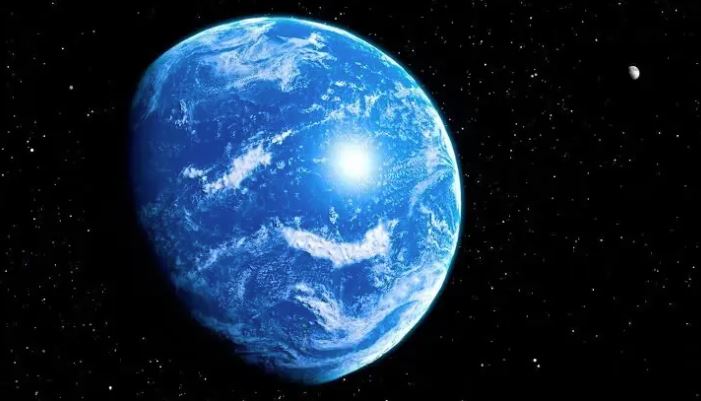
With the help of NASA's James Webb Telescope, astronomers have been able to observe a new planet that could be completely covered by a deep ocean.
According to The Guardian newspaperObservations revealed the presence of water vapor and traces of methane and carbon dioxide in the atmosphere of the exoplanet, which has a radius twice that of Earth, and is about 70 light-years away. This chemical mix is consistent with an aquatic world with an ocean spanning its entire surface and a hydrogen-rich atmosphere, according to researchers from the University of Cambridge, although they don't think it's a calm, welcoming seascape.
Such a warm ocean could still be liquid, “but it is not clear whether it is habitable,” according to the Cambridge researchers.
“The ocean temperature can be over 100 degrees [Κελσίου] Or more,” said Professor Nico Madhusudan. He added that at high atmospheric pressure, such a warm ocean could remain liquid, “but it is not clear whether it would be habitable.”
Artistic rendering of a planet with a boiling ocean – Image Guardian/Amanda Smith/PA
The other explanation
This interpretation was supported in a paper published in the journal Astronomy and Astrophysics Letters, but was disputed by a Canadian team that made additional observations of the same exoplanet, known as TOI-270 d. They have detected the same chemicals found in the atmosphere, but argue that the planet would be too hot, perhaps 4,000°C, to have water – instead they believe it has a rocky surface supplemented by an incredibly dense atmosphere of hydrogen and water vapor.
Whatever view one may come to about habitability conditions beyond Earth, these latest observations demonstrate the stunning insights that the James Webb Telescope provides into the nature of planets outside our solar system. The telescope captures starlight that has been “filtered” through planetary atmospheres to provide detailed analyzes of the chemical elements they contain.
From this, astronomers can build a picture of the conditions on the planet's surface and the likelihood of life surviving there.
The James Webb Telescope reveals a distant exoplanet: a possible water worldhttps://t.co/2SMfd9RHpf
– Buzz Blog (@buzzblog4) March 8, 2024
Can he host life?
Evidence for an ocean in TOI-270 d relies on the absence of ammonia, which should occur naturally in a hydrogen-rich atmosphere. But ammonia is very soluble in water, so it would be depleted in the atmosphere if there was an underground ocean. “One explanation is that this is a water ocean under a hydrogen-rich atmosphere,” Madhusudan said.
Conditions will be very different from those on Earth. TOI-270 d is non-tidal, meaning one side is permanently facing the sun and the other is immersed in eternal darkness, creating extreme temperature contrasts.
“The ocean will be very warm on the day side. The night side could host life,” Madhusudan said.
On the other hand, Professor Björn Beneke, from the University of Montreal, questions the “water world” hypothesis. “The temperature from our point of view is too high for water to be liquid,” he said, adding that the atmosphere appears to contain large amounts of water vapor, too large an amount to imagine an ocean. On the surface, temperatures can reach 4,000 degrees Celsius, Beinecke estimates, with water in a state where the distinction between liquid and gas becomes blurred. “It's almost like a thick, warm liquid,” he said.

“Total alcohol fanatic. Coffee junkie. Amateur twitter evangelist. Wannabe zombie enthusiast.”





More Stories
Motorola Razr 50 Ultra Review – Review
6 Phrases That Show You’re Mentally Stronger Than Most People
Maniskin: They were honored for their overwhelming success in Greece.